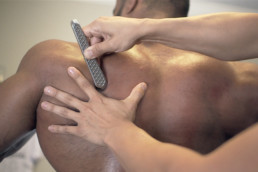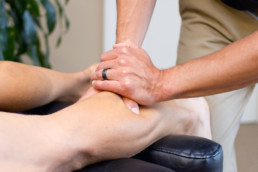Graston Technique
Graston Technique® is an evidence-based form of instrument assisted soft tissue mobilization (IASTM) that precisely detects and treats fascial restrictions as well as muscle and tendon dysfunction. Following the kinetic chain, Graston Providers can target and treat affected tissues often resolving issues once thought to be permanent.

Active Release Techniques may help the body...
Improve Motion
Quickly improves range of motion and flexibility of joint and soft tissue structures.
Drug-Free Pain Relief
Decreases pain intensity and pain pressure thresholds quickly and effectively.
Restore Function
Releases fascial restrictions, entrapped nerves, vasculature and soft tissue dysfunction.
What is Graston Technique?
Graston Technique is a soft tissue technique designed to break cross-fiber scar tissue links, splay these fibers and increase fascial mobility. When clinically indicated, GT is also used to re-initiate the inflammatory process by introducing small amounts of micro-trauma to the tissue. This results in a fresh new flow of blood, nutrients and fibroblasts to the region to re-stimulate the healing cascade within the fibrotic and dysfunctional tissues.
The patented GT Instruments are used to scan the injured area and assist clinicians to locate and then treat the injured tissue that is causing pain and restricting motion. Our doctors utilize the instruments to supply precise pressure to break up scar tissue, which relieves discomfort and restores normal function. The technique involves the use of six hand held stainless steel instruments specifically designed to detect and effectively treat areas exhibiting soft tissue fibrosis or chronic inflammation. The instruments are shaped to fit the various contours of the body in order to maximize treatment efficacy. This design allows for ease of treatment and maximum tissue penetration specifically in regions of the body which are hard to access with the doctors hands (such as the plantar fascia at the heel). The Graston Technique Instruments, much like a tuning fork, resonate in the doctors’ hands allowing the doctors to isolate adhesions and restrictions, and treat them very precisely. Since the metal surface of the instruments does not compress like the fat pads of the finger, deeper restrictions can be accessed and treated. When explaining the properties of the instruments, the analogy of a stethoscope can be used. Just as a stethoscope amplifies what the human ear can hear, so do the instruments increase significantly what the human hands can feel.
Prior to each and every Graston treatment, a specially designed lubricant is applied to the skin. This lubricant allows the treatment instruments to glide over the skin without causing irritation. Graston Technique® is then administered in multiple directions in order to break up the soft tissue lesion/scar tissue in all fascial planes. As the GT instruments are applied, a “vibratory” sensation is felt through the tool to the doctors’ fingertips. The patient simultaneously experiences a similar sensation while the tool traverses the area being treated.
A groundbreaking approach to soft-tissue treatment.
Physiologic Benefits
Stimulate Healing
Graston treatment is thought to stimulate connective tissue remodeling through resorption of excessive fibrosis, along with inducing repair and regeneration of collagen secondary to fibroblast recruitment. In turn, this will result in the release and breakdown of scar tissue, adhesions, and fascial restrictions. In laboratory studies using a rat model, the use of instruments resulted in increased fibroblast proliferation and collagen repair in cases of enzyme-induced tendinitis. These findings provide initial support for IASTM stimulating connective tissue remodeling.
Increase Range of Motion
The utilization of Graston Technique has been reported to produce a localized inflammatory response, reduce soft-tissue adhesions, and increase range of motion and mobility in those with musculoskeletal disorders. Several studies have demonstrated significant changes in range of motion compared to the control group.
Pain Relief
There is some evidence that demonstrates that Graston Technique / IASTM can reduce pain intensity and pain pressure thresholds post treatment. Several studies have shown improved symptoms of lower back pain, considered to be one of the leading sources of dysfunction among adults.
What Conditions Will Benefit?
Graston Technique is effective for treatment of soft-tissue conditions or MSDs – including tightness, pain, tingling, inflammation, restricted range of motion, muscle ache, and related symptoms.
- Arthritis
- Sports Injuries
- Neck Pain (Cervical Sprain / Strain)
- Back Pain (Lumbar Sprain / Strain)
- Knee Pain (Patellofemoral Disorders)
- Ankle Pain (Achilles Tendinitis)
- Foot Pain (Plantar Fasciitis)
- Shoulder Pain (Rotator Cuff Tendinitis)
- Tennis Elbow (Lateral Epicondylitis)
- Golfer’s Elbow (Medial Epicondylitis)
- Wrist Pain (Carpal Tunnel Syndrome)
- IT Band (Iliotibial Band)
- Repetitive Stress Injuries
- TMJ
- Muscle Strains
- Ligament Sprains
- Shin Splints

Learn More About Graston Technique
What to Expect During Treatment
Treatment sessions last about 15-minutes and many patients experience dramatic reduction in pain and increase in range of motion after their first treatment. Most problems are resolved in five or fewer treatments. Patients are advised they may be sore, bruised or exhibit small red dots over the area treated, called petechiae. If any soreness is felt after the procedure, ice application for 15 to 20 minutes following the treatment may ease the discomfort.
How Many Treatments Are Recommended?
How many sessions a person needs depends on the severity of the health concern. While many people may benefit from a single session, often times more complex conditions may require more frequent treatment.